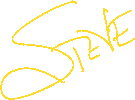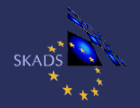- display options ▼
- normal
- full width
 |
SKADS: Newsletter June 2006 |  |
The European SKA Design Study project is in full operation since its kickoff last November 2005. The next milestone is our first annual report which must be submitted to the EC on August 10th. This will be quickly followed by our first SKADS Workshop to be held September 4th in Paris. The SKADS Workshop is the first day of a whole week of SKA activities in Paris. For more information, and to register, please visit the International SKA website at http://www.skatelescope.org/SKAmeeting_Paris. All are welcome to attend the SKADS workshop!
SKADS Recruitment
The SKADS Management Team is now complete with the recruitment of André van Es in the role of Project Manager for SKADS. André graduated in aerospace engineering in 1987 at the TU of Delft, where he specialised in experimental low speed aerodynamics. He spent eleven years as an engineer at HSA, a dutch radar company, where he worked as an analyst and system designer for a number of projects including a phased-array radar. He joined ASTRON in August 2000 as the head of the Process Support Group, a group that is in charge of planning and control of all ASTRON projects. André has been involved in several projects at ASTRON including VISIR, LOFAR PDR, MIDI and THEA. With his extensive experience in radio astronomy engineering and management, we are very fortunate to have André on-board!
Recruitment continues apace within the rest of the SKADS project. At Cardiff University, interviews are currently underway to select a postdoctoral research associate to work on the SKA network simulator within Design Study 3 of SKADS.
We’re looking forward to welcoming Shanmugha Sundaram who will join JIVE to work with Cormac Reynolds on astronomical data simulations as part of Design Study 2, Task 2. Shanmugha is currently a research scientist at the Indian institute of Astrophysics, in Bangalore, India, and we expect him at JIVE this summer. His research interests include low frequency studies of solar noise storms and antenna and RF engineering.
With the recent success of the UK PPARC proposal, Oxford University has made two appointments for work in SKADS. Matt Jarvis is the manager for the Science Simulations task of Design Study 2 which is under the leadership of Steve Rawlings. Matt’s research is focused on observational cosmology with particular emphasis on the coevolution of galaxies and black holes over the history of the Universe. After receiving his PhD from Oxford in 2000, he moved to Leiden as a postdoctoral fellow of the RTN Network "The Physics of the IGM". In 2002 he returned to Oxford as a PPARC PDRA. Matt manages the ambitious science simulations task whose aim is to generate simulations across the whole of the Key Science projects in order to define the SKA that can carry out the most science in an optimal way. Matt began in SKADS with the organisation of an excellent workshop in Oxford on June 7th which brought together all the partners in Europe working on science simulations.
Hans-Rainer Klöckner also joins the SKADS project to work on the more practical side of the simulations. Task-2 of Design Study 2 investigates the radio sky as seen through the telescope, and Hans will be particularly involved in calibration issues. Hans has been a research associate at Oxford since 2004. He held a postdoctoral position at ASTRON for a brief time after receiving his PhD from the Kapteyn Institute in 2004. Hans main area of scientific interest is in line studies of Ultra Luminous IR Galaxies, and young galaxies, using just about all the world’s major radio astronomical instruments.
The Max Planck Institute for Radio Astronomy in Bonn is expecting the imminent arrival of Dharam vir Lal, most recently from the Academia Sinica Institute of Astronomy and Astrophysics in Taipei. Dharam completed his PhD at the Tata Institute for Fundamental Research in Pune, India. He has held postdocs at Leiden University, and at ASIAA in Taipei. He has worked on calibration issues for low frequency arrays in presence of ionospheric seeing disc, and his knowledge and experience in this area will be invaluable to the scientific simulations undertaken within Task-2 of Design Study 2.
In France, in collaboration with the Horizon Project, there is a concentrated effort in the area of sky simulations related to the Epoque of Reionisation. Paola di Matteo joined the Observatoire de Paris in 2005 after completing her PhD at Universitat di Roma "La Sapienza" where she worked on globular cluster dynamics in a galactic tidal field. In September this year, she will move into a SKADS postdoctoral position working full time on simulations of the Epoque of Reionisation. Paola joins team member Benoit Semelin at Observatoire de Paris under the leadership of Francoise Combes.
There are a number of SKADS positions available, all of which are posted on the SKADS website. We welcome all applicants and recommendations, so please have a look at http://www.skads-eu.org/p/jobs.htm
EMBRACE
The principal hardware effort within SKADS is the EMBRACE demonstrator. EMBRACE is the Electronic MultiBeam Radio Astronomy ConcEpt and it will be an aperture-plane phased-array using tiles of Vivaldi feed antennas. This concept was initially developed by ASTRON as the "Thousand Element Array" or ThEA. EMBRACE will have installations at Westerbork and Nancay for a total collecting area of 400 square metres (equivalent to a 20m diameter single dish). The first EMBRACE antenna boards with integrated electronics have been manufactured and are currently being integrated (see photos). Testing of a prototype tile will begin this summer.

This picture shows the board containing the rf circuitry. The entire tile is visible. |

The board shows some of the components being assembled. The KDI’s vector modulator are shown. |
|
|
||
Steve Torchinsky
SKADS Project Scientist
14 June, 2006
http://www.skads-eu.org
